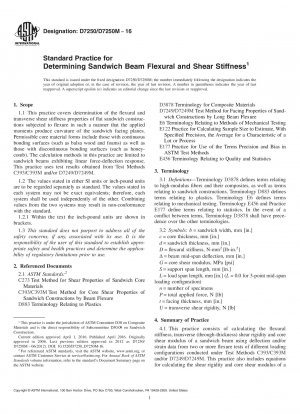ASTM D7250/D7250M-16
Standard Practice for Determining Sandwich Beam Flexural and Shear Stiffness
- Standard No.
- ASTM D7250/D7250M-16
- Release Date
- 2016
- Published By
- American Society for Testing and Materials (ASTM)
- Status
- Replace By
- ASTM D7250/D7250M-20
- Latest
- ASTM D7250/D7250M-20
- Scope
5.1 Flexure tests on flat sandwich constructions may be conducted to determine the sandwich flexural stiffness, the core shear strength and shear modulus, or the facings compressive and tensile strengths. Tests to evaluate core shear strength may also be used to evaluate core-to-facing bonds.
5.2 This practice provides a standard method of determining sandwich flexural and shear stiffness and core shear modulus using calculations involving measured deflections of sandwich flexure specimens. Tests can be conducted on short specimens and on long specimens (or on one specimen loaded in two ways), and the flexural stiffness, shear rigidity and core shear modulus can be determined by simultaneous solution of the complete deflection equations for each span or each loading. If the facing modulus values are known, a short span beam can be tested and the calculated bending deflection subtracted from the beam's total deflection. This gives the shear deflection from which the transverse shear modulus can be determined.
Note 1: Core shear strength and shear modulus are best determined in accordance with Test Method C273 provided bare core material is available.
Note 2: For cores with high shear modulus, the shear deflection will be quite small and ordinary errors in deflection measurements will cause considerable variations in the calculated shear modulus.
Note 3: To insure that simple sandwich beam theory is valid, a good rule of thumb for a four-point bending test is the span length divided by the sandwich thickness should be greater than 20 (L1/d > 20) with the ratio of facing thickness to core thickness less than 0.1 (t/c < 0.1).
1.1 This practice covers determination of the flexural and transverse shear stiffness properties of flat sandwich constructions subjected to flexure in such a manner that the applied moments produce curvature of the sandwich facing planes. Permissible core material forms include those with continuous bonding surfaces (such as balsa wood and foams) as well as those with discontinuous bonding surfaces (such as honeycomb). The calculation methods in this practice are limited to sandwich beams exhibiting linear force-deflection response. This practice uses test results obtained from Test Methods C393/C393M and/or D7249/D7249M.
1.2 The values stated in either SI units or inch-pound units are to be regarded separately as standard. The values stated in each system may not be exact equivalents; therefore, each system shall be used independently of the other. Combining values from the two systems may result in non-conformance with t......
ASTM D7250/D7250M-16 Referenced Document
- ASTM C273 Standard Test Method for Shear Properties of Sandwich Core Materials
- ASTM C393/C393M Standard Test Method for Core Shear Properties of Sandwich Constructions by Beam Flexure
- ASTM D3878 Standard Terminology Composite Materials
- ASTM D7249/D7249M Standard Test Method for Facesheet Properties of Sandwich Constructions by Long Beam Flexure
- ASTM D883 Standard Terminology Relating to Plastics
- ASTM E122 Standard Practice for Calculating Sample Size to Estimate, With a Specified Tolerable Error, the Average for Characteristic of a Lot or Process
- ASTM E177 Standard Practice for Use of the Terms Precision and Bias in ASTM Test Methods
- ASTM E456 Standard Terminology for Relating to Quality and Statistics
- ASTM E6 Standard Terminology Relating to Methods of Mechanical Testing
ASTM D7250/D7250M-16 history
- 2020 ASTM D7250/D7250M-20 Standard Practice for Determining Sandwich Beam Flexural and Shear Stiffness
- 2016 ASTM D7250/D7250M-16 Standard Practice for Determining Sandwich Beam Flexural and Shear Stiffness
- 2006 ASTM D7250/D7250M-06(2012) Standard Practice for Determining Sandwich Beam Flexural and Shear Stiffness
- 2006 ASTM D7250/D7250M-06 Standard Practice for Determining Sandwich Beam Flexural and Shear Stiffness

Copyright ©2024 All Rights Reserved